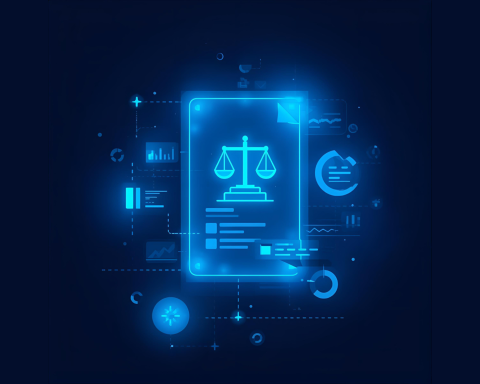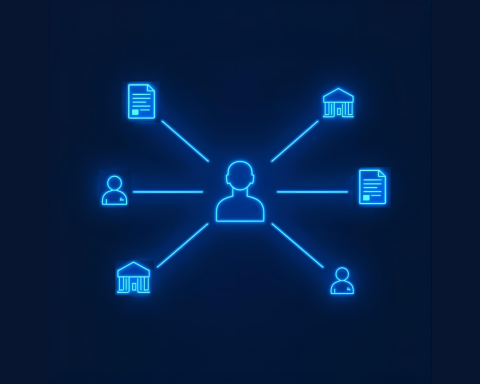Introduction
Conducting diligent judicial research plays a pivotal role in shaping case strategy and outcomes. Judges wield significant authority in interpreting and applying the law, making informed decisions based on their judicial philosophies, past rulings, and personal backgrounds. Therefore, understanding a judge’s tendencies, biases, and legal interpretations is crucial for attorneys, litigators, and other legal professionals navigating the complexities of the courtroom. Thorough research empowers legal practitioners to anticipate potential challenges, tailor arguments effectively, and present their cases with precision. In our 2024 Judicial Research Survey, Courtroom Insight gathered insights on the current state of judicial research to highlight best practices and difficulties regarding judicial research.
Methods
A. Procedure
The survey was conducted online through Survey Monkey’s platform, and respondents’ personal identities remained anonymous. Respondents were prompted to respond to a set of 16 questions regarding judicial research methods, obstacles faced, and other relevant factors. The questions were designed to gather information about the respondents’ experiences with judicial research and their opinions about the current state of the field. The survey was open to all legal professionals with experience in judicial research, and participation was voluntary.
B. Participants
In total, 115 respondents participated in the Judicial Research Survey, representing diverse roles related to judicial research. Paralegals constituted the largest proportion of respondents at 43.86%, followed by attorneys at 24.56%, law librarians at 19.30%, and other professionals at 12.28%. Regarding employer distribution, large law firms accounted for the largest portion at 44.74%, followed by small law firms/private practices at 28.07%, insurance companies at 14.04%, expert witness organizations at 9.65%, and other entities at 3.51%. Geographically, respondents were spread across various regions, with the Northeast US having the highest representation at 34.21%, followed by the South US at 25.44%, the West US at 22.81%, the Midwest US at 13.16%, Canada at 2.63%, the United Kingdom at 0.88%, and other international locations at 0.88%. These demographics showcase a diverse cross-section of professionals contributing insights from different job titles, employer types, and geographic regions within the legal landscape.
C. Data Analysis
The data collected from the survey were analyzed using descriptive statistics. The results were tabulated and presented using tables and charts to facilitate interpretation. The analysis focused on identifying patterns and trends in the responses to the survey questions, as well as exploring the relationships between different variables.
Results
A. What resources do you use when conducting judicial research?
The top three resources utilized are consulting 3rd party databases (e.g., Courtroom Insight) (54.87%), relying on an internal research team (39.82%), and performing internet searches (37.17%). This suggests a reliance on comprehensive external databases and internal expertise, supplemented by general internet searches, indicating a preference for diverse sources of information.
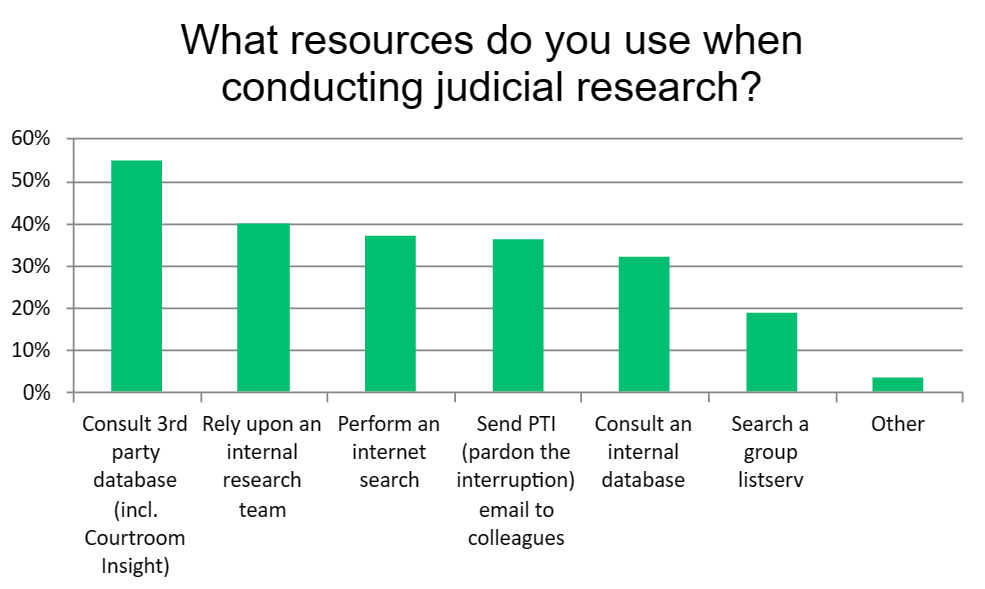
B. When do you begin performing judicial research?
Respondents predominantly begin performing judicial research when an attorney requests it (38.94%), followed closely by initiating research after a judicial assignment or appointment (37.17%). This indicates that research activities are often driven by specific requests or events within the legal process, emphasizing the reactive nature of research in response to immediate needs.
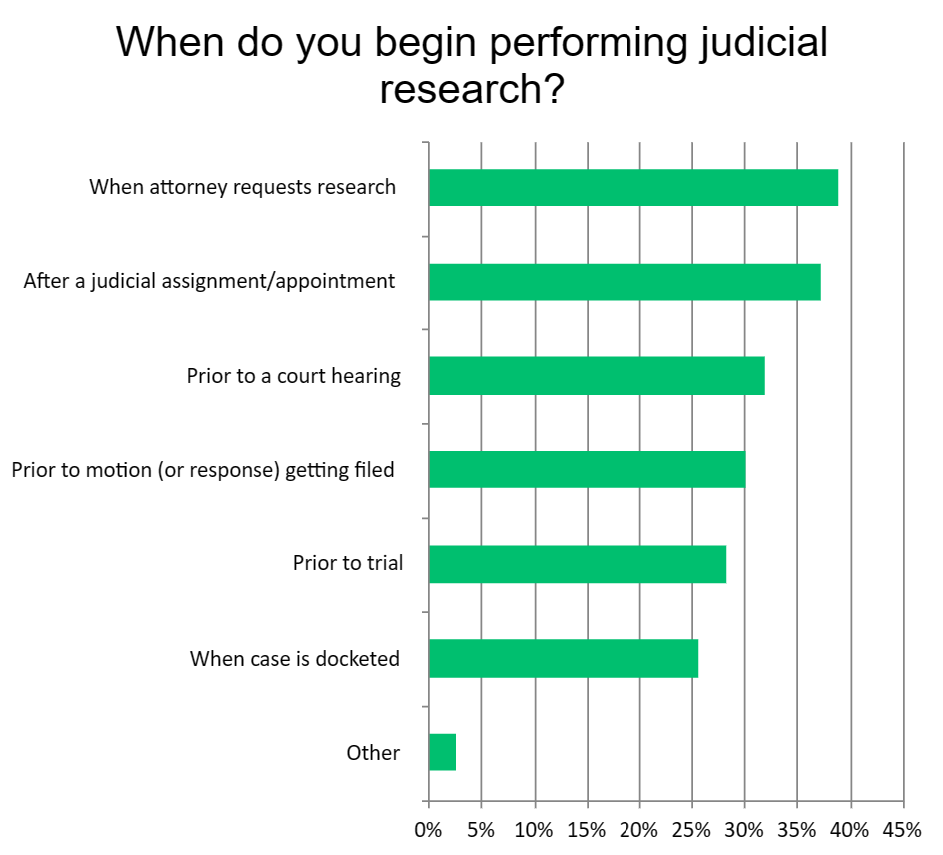
C. Does your organization have a formalized process for collecting and sharing judicial research?
Half of the organizations surveyed have formalized processes for collecting and sharing judicial research (50.88%), indicating a significant emphasis on structured procedures within legal research practices. However, the nearly equal split suggests that the other half may rely on more informal methods or lack standardized processes altogether.

D. What is your organization’s process for sharing judicial research?
The primary methods for sharing judicial research include pinning information to judge profiles in Courtroom Insight (50.91%) and storing data in Excel spreadsheets or Google Sheets (43.64%). This suggests a preference for digital platforms and organized data storage solutions, facilitating efficient access and collaboration among legal professionals.

E. How important are various data sources when researching a judge?
Rulings on motions (both decisions and jurisdiction) rank highest in importance (5.45 weighted score), followed closely by case opinions (5.22 weighted score) and recommendations/personal experiences appearing before the judge (5.1 weighted score). This underscores the significance of legal outcomes and firsthand experiences in evaluating judicial behavior and decision-making processes.
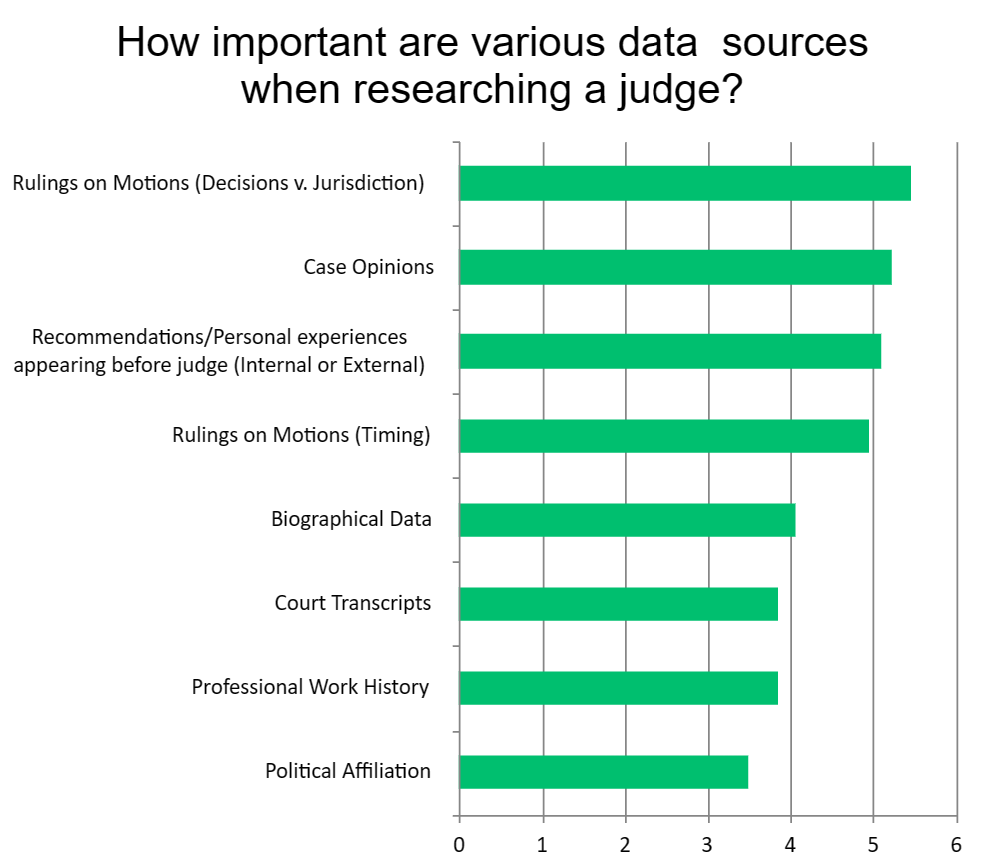
F. Does the information requested on a judge differ for Federal versus State courts?
A majority of respondents (58.88%) indicated that the information requested on a judge does not differ between Federal and State courts. However, a significant proportion (41.12%) noted differences, suggesting varying information needs based on court jurisdiction or specific case requirements.
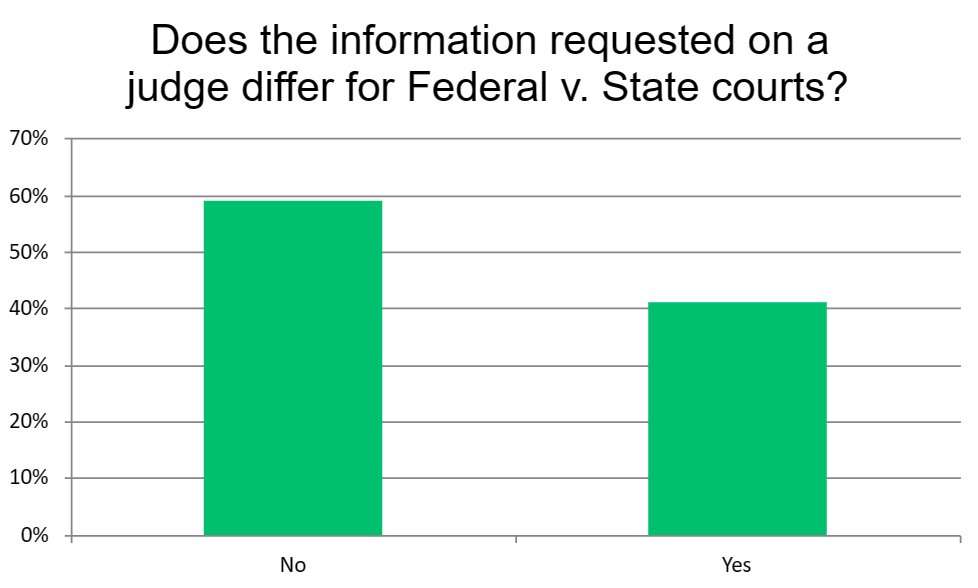
G. How does the information requested on a judge differ for Federal versus State Courts?
The most common response was that federal and state court research often departs due to their differing legal requirements. This highlights the importance of using customized research strategies based on a judge’s jurisdiction.
H. Does the information requested on a judge differ for Plaintiff versus Defense engagements?
A majority of respondents (62.26%) indicated that the information requested on a judge does not differ between plaintiff and defense engagements. However, a significant minority (37.74%) noted differences, suggesting varying information needs based on the role of the litigating party. The most common response indicates that plaintiffs are typically more proactive about seeking information on a judge because it may impact litigation strategy.
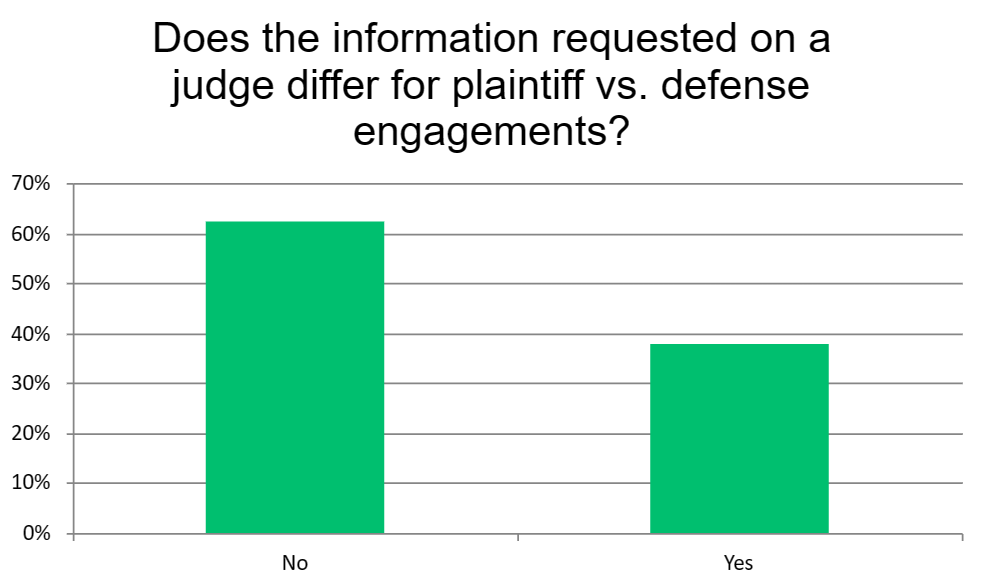
I. How does the information requested on a judge differ for Plaintiff versus Defense engagements?
For organizations that prepare internal data analytics on judges, three common types of analytics are outcome prediction, visualization tools, and cost estimations. These analytics tools enable organizations to enhance decision-making processes and gain insights into judicial behavior and case outcomes.
J. What external data sources do you rely on for judicial research?
The top external data sources relied on are LexisNexis (44.23%) and Lex Machina (44.23%), followed by Courtroom Insight (39.42%), Westlaw (35.58%), and Bloomberg (33.65%). This indicates a preference for comprehensive legal databases and analytics platforms, highlighting the importance of accessing diverse sources of information for thorough judicial research.

K. How do you reconcile and/or prioritize information gathered from different resources?
The most common approach to reconciling and prioritizing information from different resources is leaving it to the attorney to make this determination. Additionally, respondents leverage different tools for their specific strengths, such as Bloomberg for labor-related information and Lex Machina for ease of use, suggesting a tailored approach based on the unique features of each resource.
L. Does your organization prepare any internal data analytics on judges?
While a majority of organizations do not prepare internal data analytics on judges (54.37%), a significant portion do engage in this practice (45.63%). For those organizations, common types of analytics prepared include outcome prediction, visualization tools, and cost estimations, reflecting a growing emphasis on data-driven insights in legal decision-making processes.

M. For organizations that prepare internal data analytics on judges, what kind of analytics are prepared?
- Outcome prediction: Data analytics aimed at predicting the likely outcome of legal cases to help legal professionals make more informed decisions and strategies.
- Visualization tools: Software tools that represent legal data, information, and relationships visually through charts and graphs to aid legal professionals in analyzing and understanding judge data more effectively.
- Cost estimations: Estimations of the potential costs associated with legal proceedings, which help parties understand and plan for the financial implications of pursuing or defending legal claims.
N. What obstacles do you commonly encounter during judicial research?
The most common obstacles encountered during judicial research include a lack of knowledge sharing within the firm (42.16%), a lack of information about a judge (34.31%), and current resources not providing comprehensive profiles (33.33%). These challenges highlight the importance of addressing internal communication and resource limitations to enhance the efficiency and effectiveness of research efforts.

O. At the conclusion of a case, how is judicial research stored?
At the conclusion of a case, judicial research is most commonly saved to a personal hard drive (48.48%) or stored in an external database such as Courtroom Insight (37.37%). A smaller proportion is stored in an internal database (31.31%), while filing with the case is less common (23.23%), indicating a preference for digital storage solutions and personal organization methods among legal professionals.

P. What types of information or data sources do you wish would be available to help you with judicial research?
Respondents expressed a desire for access to several types of information or data sources to aid in judicial research. The top three requests include access to code of legal ethics and guidelines documents, real-time court cases, and better analytics. These requests reflect a need for comprehensive and up-to-date resources to support informed decision-making and strategy development in legal proceedings.
Conclusion
In conclusion, the analysis of the 2024 Judicial Research Survey underscores the critical role of diligent research in navigating the complexities of the legal landscape. With judges wielding significant authority in shaping case outcomes, understanding their tendencies, biases, and legal interpretations is paramount for legal professionals. The survey revealed insights into the diverse practices and challenges surrounding judicial research, including the reliance on various resources such as third-party databases and internal expertise, as well as the importance of structured processes for collecting and sharing research findings. Despite differences in court jurisdictions and litigating parties, the majority of respondents emphasized the universal importance of thorough research in informing litigation strategies. Looking ahead, addressing obstacles such as knowledge sharing within firms and enhancing access to comprehensive data sources will be crucial for empowering legal practitioners to navigate the evolving legal terrain effectively.
Want to access the full PDF research results? Download below:
Interested in watching the recorded webinar? See below:
About Courtroom Insight
Courtroom Insight (“CI”) connects legal professionals, matters, and data. Our leading knowledge management solution enables law firms, insurance companies, and other legal organizations to capture, share, and analyze critical information about legal professionals, such as expert witnesses, judges, and neutrals. Learn more at: our website or LinkedIn.

